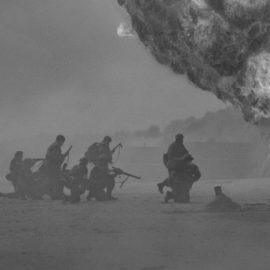

This article is an excerpt from the Shortform book guide to "The 1619 Project" by Nikole Hannah-Jones. Shortform has the world's best summaries and analyses of books you should be reading.
Like this article? Sign up for a free trial here .
What is Nikole Hannah-Jones’s The 1619 Project about? What role did slavery play in American history?
The 1619 Project: A New Origin Story is an anthology of essays edited by Nikole Hannah-Jones and co-created with the New York Times that seeks to reframe American history with the institution of slavery at its core. The essays also explore how the institution of slavery has impacted our economy, laws, society, and the livelihoods of Black Americans.
Below is a brief overview of The 1619 Project: A New Origin Story.
The 1619 Project
In The 1619 Project: A New Origin Story, Nikole Hannah-Jones asserts that American history began in 1619 with the arrival of the first ship of enslaved Africans, one year before the Mayflower arrived. It also argues that, American democracy and the prosperous nation we know today were largely built by enslaved Black Americans but that this demographic is almost entirely excluded from America’s founding stories and remains suppressed today due to racist institutions that persist from slavery.
Nikole Hannah-Jones is an award-winning investigative journalist and staff writer for the New York Times who specializes in racial injustice. She won the Pulitzer Prize for her work on The 1619 Project and is also the recipient of a Peabody Award, two George Polk Awards, and three National Magazine Awards.
The Real Story of America
Hannah-Jones argues that American history began in 1619 with the arrival of the first ship of enslaved Africans and that the popular story of America’s founding is a mythology of half-truths and inaccurate information. This section will discuss the central myths of America’s founding story and provide a more complete perspective based on historical events.
Myth 1: The American Colonists Succeeded Due to Their Hard Work
Hannah-Jones argues that the reality of this myth is that the survival and prosperity of American colonists were almost entirely due to the labor of enslaved Black Americans.
In 1619, the first boat of enslaved Africans arrived in Jamestown, Virginia, and they began clearing land and building homes for British colonists. They then taught colonists how to grow rice and protect themselves from diseases like smallpox, saving them from starvation and sickness.
Enslaved Africans also built the infrastructure of the early American economy—they cleared land, built plantations, picked cotton, and laid down the railroads that transported cotton to the North where it was made into textiles. Cotton was the nation’s most valuable export and the foundation of American wealth.
And their labor wasn’t the only contribution enslaved Africans made to the American economy—their bodies were also bartered, traded, and mortgaged to build the fortunes of wealthy white people in the North and South. This trading and mortgaging established Wall Street and made New York City the financial capital of the world.
Ultimately, without the forced labor of enslaved Black Americans, the first colonists may not have even survived, and the rapid growth and prosperity of the nation wouldn’t have been possible.
Myth 2: Abolitionists in the North Led the American Revolution and Crafted American Democracy
Hannah-Jones explains that the myth of the “free abolitionist North” righteously leading the American Revolution, writing the founding documents, and crafting American democracy is based on half-truths, hypocrisies, and inaccurate information. She argues that the reality is that (1) the Revolutionary War was not truly fought in the name of freedom and justice; (2) the North wasn’t as righteous as it’s given credit for; and (3) Black Americans were the ones to truly create and establish American democracy.
First, the American Revolution was largely an effort to prevent Britain from abolishing American slavery and was sparked by wealthy enslavers in the North and South (like George Washington). The colonists feared that Britain would immediately impose their abolitionist ideals on them. This concerned white enslavers because it would bring economic losses and violent retribution from their former slaves. This also concerned poor whites because although they were low on the social hierarchy, their whiteness gave them a sense of superiority which they would lose if slavery were abolished.
Second, Hannah-Jones argues that the myth of America breaking from Britain to provide “freedom and justice for all” is hypocritical. This creed, which was emphasized throughout America’s founding documents, didn’t really mean all. Black Americans were viewed as property and therefore not entitled to human rights like freedom or justice.
Third, the myth of the “free abolitionist North” leading the fight for American freedom is historically inaccurate—Hannah-Jones says that the North was neither free (they also owned slaves and participated in the slave trade) nor abolitionist at this time. Further, the authors of America’s founding documents (like the Declaration of Independence and the Constitution) were all slave owners and mostly Virginian Southerners like Thomas Jefferson and James Madison.
However, despite being excluded from America’s founding documents, Black Americans have been the ones to most fervently uphold and represent the tenets and ideals of democracy. Hannah-Jones argues that Black Americans repeatedly fought for their freedom until abolition in 1863 and were ardently involved in perfecting democracy afterward—through movements like Civil Rights and Black Lives Matter, they’ve pushed for legislation that provides equal rights, representation, opportunities, and treatment not only for themselves but for other minorities as well.
The Impact of Slavery on Modern America
The authors argue that the institution of slavery can be directly linked to modern injustices in America’s taxation system, legal and justice systems, and healthcare systems. This section will explore how the history of slavery and segregation in America has shaped modern systematic injustices.
(Shortform note: The citations in this section, “The Impact of Slavery on Modern America,” will switch from “Hannah-Jones” to “the authors.” This is because the material in these sections comes from chapters 2-18 of The 1619 Project, each of which was written by a different author.)
American Regressive Taxation
The authors explain that regressive taxation in America allows large wealthy corporations like Amazon and Netflix to avoid paying taxes and results in economic inequality and poor social initiatives like a lack of funding for public schools and healthcare. This taxation became prominent in the late 18th century because of Southern efforts to preserve slavery.
The Origin of Regressive Taxation
Regressive taxation became dominant in America because of the three-fifths compromise—a ploy by the South to preserve slavery. The compromise allowed Southern states to count three-fifths of their enslaved populations as “people” in the House of Representatives—this arbitrarily inflated their populations while denying citizenship and voting rights to enslaved people. Their high population counts then granted them political leverage over the North, allowing them to veto national policy and preserve slavery.
However, when the country started to implement taxation, the three-fifths compromise implied that Southern states would pay more taxes because of their higher populations. So to avoid a higher tax rate, Southerners pushed for imports to be taxed instead of people—meaning consumers would ultimately pay higher prices to cover the tax on the imports they purchased. This began the long-standing tradition of American taxation being hidden in consumerism and the wealthy being able to avoid paying their fair share—the root of American regressive taxation.
The Impacts of Regressive Taxation Today
The authors argue that regressive taxation is why America lacks funding for social initiatives and is riddled with economic inequality—the wealthiest people and corporations can avoid paying their fair share of taxes, so the bulk of public funds is pulled from the pockets of modest families and amounts to a relatively small sum compared to the total wealth in America (most of which remains in the pockets of the wealthiest 1%).
The authors continue to explain that progressive taxation and higher income tax for the wealthy would dissolve some of the maladies America faces. This would provide the nation with more funding to spend on public programs that would help low-income families gain opportunities and resources, ultimately minimizing economic inequality.
American Laws and Justice
The authors add that another impact of slavery on modern America is the enforcement of laws, which often favors white people and is unjust toward Black people. This is due to persisting attitudes and beliefs from slavery. This section will discuss a few American laws and practices that fail to provide liberty and justice for Black Americans.
Rape Laws
The authors explain that for Black women, laws regarding rape rarely result in justice due to stereotypes developed during slavery. A study conducted in Kansas City and Philadelphia found that prosecutors are 4.5 times more likely to file charges in rapes when the victims are white than Black. And, if the victim is Black, the accused are more likely to be acquitted or receive a light sentence if convicted.
The authors argue that these injustices are due to persisting stereotypes from slave times that make Black women and girls out to be hypersexual, or “Jezebels.” These stereotypes developed to justify and encourage the rape of Black women by their white enslavers—the belief claimed that Black women and little girls were promiscuous and always consenting, and therefore couldn’t be “raped.” The stereotype was publicly endorsed by newspapers so that American enslavers would produce more slaves—the children of these rapes became the property of their mothers’ rapists.
Self-Defense Laws
The authors argue that because of stereotypes and cultural mindsets that persist from slavery, the right to self-defense is leniently granted to white people while often being withheld from Black people.
When a Black person commits a violent act against a white person in defense of their life, they’re much more likely to be persecuted and denied their right to self-defense than if they were white. Similarly, white people have a much higher chance of being acquitted for a violent act against a Black person by claiming self-defense, whether or not the act was justified. The authors point to the case of Breonna Taylor to highlight this point, who was in bed when she was shot six times and killed by police officers during a raid on her Louisville, Kentucky home. The officers involved were acquitted because they were considered to be acting in self-defense.
The authors claim that the reason for these injustices is what they call white fear—the white cultural mindset that Black people are inherently dangerous and uncivil. This belief originated during and after slavery because whites feared that Black people would violently retaliate against the injustices inflicted upon them. Because of white fear, Blacks were intensely monitored and harshly punished through “slave codes.”
“Slave codes” were a set of rules that prevented Black people from gaining any power or equality. For example, these codes prevented Black people from testifying in court or carrying weapons but allowed enslavers to freely kill any of their slaves as they deemed necessary. When slavery was abolished, “Black Codes” were enforced in the south to patrol and monitor Blacks, mirroring the laws of slave codes. Soon after came Jim Crow—a set of laws that segregated Black people, enforced white supremacy, and established Blacks as second-class citizens.
So while Black Americans have been “free and equal” on paper since Jim Crow was abolished in 1964, the white fear that developed these forms of oppression remains ingrained into American culture and the justice system today.
Punishment Laws
The authors assert that in the justice system, Black individuals are punished more severely than white individuals who’ve committed the same offenses. The authors argue that these racist decisions stem from white fear and the legal and judicial precedents that remain from slavery.
For example, Black prisoners convicted of killings are more likely to be sentenced to death than whites facing the same conviction—a study from the 1980s found that in Georgia, Black prisoners were 22 times more likely to be sentenced to death.
Healthcare and Black Well-Being
The authors add that another impact of slavery on modern America is the poor health and well-being of Black people. Black Americans are more prone to illness due to segregated living conditions, and they receive poor treatment in hospitals due to misinformation and racist beliefs that exist in the healthcare industry. These issues are all remnants of the eras of slavery and Jim Crow.
Racist Systems Make Black Americans More Prone to Illness
The authors explain that Black Americans are more prone to illness than white Americans because of segregated neighborhoods and poor living conditions that remain from Jim Crow and the early 20th century.
Segregation remains today because of intentional government policies developed during and after Jim Crow. Whites didn’t want to have Black neighbors, so elected officials, city planners, and mortgage bankers decided to force Black Americans into ghettos. Elected officials made sure that these segregated neighborhoods were the only places Blacks could afford and denied them mortgages elsewhere.
Further, planners targeted Black neighborhoods for highway construction, which caused overcrowding, pollution, and health issues for residents. Homes and buildings were destroyed to make room for highway construction—so while the populations in Black neighborhoods increased, the living spaces decreased. The combination of overcrowding, a lack of clean outdoor places (like parks), and poor air quality from passing traffic greatly increased residents’ risk of diseases, especially respiratory illness. So even today, Black Americans are at a higher risk of respiratory illness and are more likely to live in crowded, polluted neighborhoods.
Segregation also puts Blacks at higher risk for diseases like diabetes. The authors say that this is because healthy food is harder to find in Black neighborhoods while mini markets selling junk food are abundant. Stores that carry healthy food tend to be in white neighborhoods which can be inaccessible to Black people who don’t have personal transportation.
Mistreatment of Black Americans in the Healthcare Industry
In addition to racist systems making Black Americans more prone to illness, the authors claim that the American healthcare industry fails to provide adequate care and treatment to Blacks due to slavery-era beliefs—particularly that Black bodies are biologically and physiologically different than white bodies.
The authors explain that academic articles claimed that Black people have thicker skin, a higher pain tolerance, and different emotional and intellectual capabilities. In 2016, a study on medical students found that half of white participants believed at least one of these claims—the most common belief was that Black people felt less pain. The authors say that this belief would make the students less likely to prescribe appropriate treatment to Black patients.
Statistics show that these racist beliefs impact the treatment of Black people in the field—for example, Black Americans are 2.8 times more likely to die of Covid-19 than white Americans and are less likely to be treated for pain. The authors link these statistics to medical practitioners’ racist beliefs that can cause them to underestimate Black illness and not provide necessary treatments.
Financial Reparations for American Slavery
Hannah-Jones states that most of the injustices Black Americans face are either caused or perpetuated by economic inequality. She argues that to eliminate this economic inequality and the injustices that follow, the government must provide Black Americans with financial aid and enhance funding for low-income and majority-Black communities.
She elaborates that Black Americans generationally lack wealth, and wealth is the factor that grants opportunities and safety in America. Wealth ensures a safe house in a good neighborhood, access to good schools, higher education, medical facilities and adequate treatment, diverse job opportunities, and more. (Hannah-Jones defines wealth more specifically than the typical definition, explaining that it not only means having assets, like money and possessions, but also investments and a lack of major debts.)
(Shortform note: Experts second this claim, citing that the higher a family’s income is, the less at risk they are for diseases or illnesses like heart disease, emphysema, vision and hearing trouble, and kidney and liver disease. Additionally, wealth serves as a “private safety net,” allowing families access to funds for adequate healthcare and healthy food, and emergency situations like divorce or disability.)
Because of slavery, Black Americans have struggled to gain assets since abolition. Many still remain trapped in low economic states without the means to break free. This section will discuss how the modern financial injustices Black Americans face are the result of slavery and Jim Crow and what these reparations entail.
Black Finances in America
The authors explain that for the majority of Americans, wealth is something that’s accumulated across generations through inheritance—when one generation dies, it passes on money and goods to the next generation. But Black Americans have historically been left with little to no inheritance, making it much harder for them to gain success and wealth compared to white Americans.
(Shortform note: Recent studies show that while inheriting wealth isn’t quite as common as the authors frame it to be, there’s still a huge gap between the inheritance expected and received by Black and white Americans. In 2019, only 10% of Black households received inheritance compared to 30% of white households. And the average sum inherited by Black households was $100,000 compared to $200,000 inherited by white households. Researchers add, like the authors, that these inheritances play a large role in perpetuating the generational Black-white wealth gap.)
Black Americans generationally lack wealth because, due to slavery, they were the first race to begin life in America with zero capital—no houses, food, clothes, or money to buy them. After being freed, the only option for the majority of former slaves was to sharecrop on their former enslavers’ land. This system continued to exploit their labor and provided barely enough money for them to feed themselves. Consequently, they were never able to accumulate wealth and pass an inheritance on to later generations.
(Shortform note: Other experts add that the sharecropping system was specifically designed to keep Black Americans dependent on their former enslavers. Once freed, Black sharecroppers were given a small plot of land, living quarters, and farming equipment from their former enslavers. In exchange, sharecroppers raised a cash crop and were required to give at least 50% of it to the landowner each year. Landowners also required the sharecroppers to pay fees out of their crop earnings, leaving them with as little as a quarter of the profit.)
And when Black people did find wealth and success in rare situations, they often faced brutality and robbery from jealous whites. In the South especially, being successful and Black was dangerous—it was seen as “stealing business” from whites and was met with destruction and even murder. Law enforcement encouraged this violence—they refused to punish white terrorists and fined Blacks exorbitant amounts for made-up crimes to put them out of business. This stripped Black people of any wealth they had.
The authors explain that white oppression of and violence toward free Black Americans was once again a result of white fear—whites were terrified that they’d be stripped of their superiority if Blacks continued to gain wealth and success.
| White Policing of Black Americans In Caste, Isabel Wilkerson discusses white supremacy, white fear, and the violent reactions to Black success during Jim Crow. She explains white people had a sense of alpha entitlement due to the racial hierarchy that dominated America since its founding. This entitlement gave them the perceived authority to police the actions of Black Americans as they deemed fit. So when Black people gained their freedom, whites felt that it was their duty and right to maintain the racial caste system. Wilkerson notes that a prime example of this is the Tulsa Race Massacre of 1921. More than a thousand white men gathered to storm a police office and lynch a young black boy who was accused of assaulting a white female. But enacting their justice on the boy wasn’t enough—the mob then entered a nearby affluent Black community and leveled it to assert their dominance. The mob shot hundreds of citizens and burned numerous homes and buildings to the ground. |
Financial Reparations
Hannah-Jones argues that the government must provide Black Americans with financial reparations to right the social and economic injustices they face because of slavery.
She explains that this compensation should be available for any American who (1) has identified as Black for more than 10 years before the reparation process begins and (2) can trace at least one ancestor back to American slavery. Black identification can be traced through historical censuses and responses to race-based questions on documents such as job and college applications. (More information on the details of these reparations can be found in Here to Equality: Reparations for Black Americans in the Twenty-First Century by William Darity Jr. and A. Kirsten Mullen.)
(Shortform note: While some claim that paying reparations for slavery isn’t feasible, the American government has paid reparations before. In 1989, Japanese Americans protested for reparations to be paid for their unfair internment during World War II. In response, the American government paid tax-free restitution of $20,000 over 10 years to surviving victims.)
Reparations should include:
- A commitment to strongly enforce civil rights prohibitions against housing, educational, and employment discrimination
- Targeted investments in Black communities that have been segregated through government policies
- Individual cash payments to descendants of enslaved people that will close the wealth gap between Blacks and whites
Hannah-Jones argues that these reparations will alleviate the systemic injustices that Black people face (like high incarceration rates and poor education, job prospects, and housing opportunities) while closing the wealth gap that feeds these injustices.

———End of Preview———
Like what you just read? Read the rest of the world's best book summary and analysis of Nikole Hannah-Jones's "The 1619 Project" at Shortform .
Here's what you'll find in our full The 1619 Project summary :
- A reframing of American history with the institution of slavery at its core
- How democracy as we know it today was largely built by enslaved Blacks
- The racist institutions that persist today that originated from slavery






